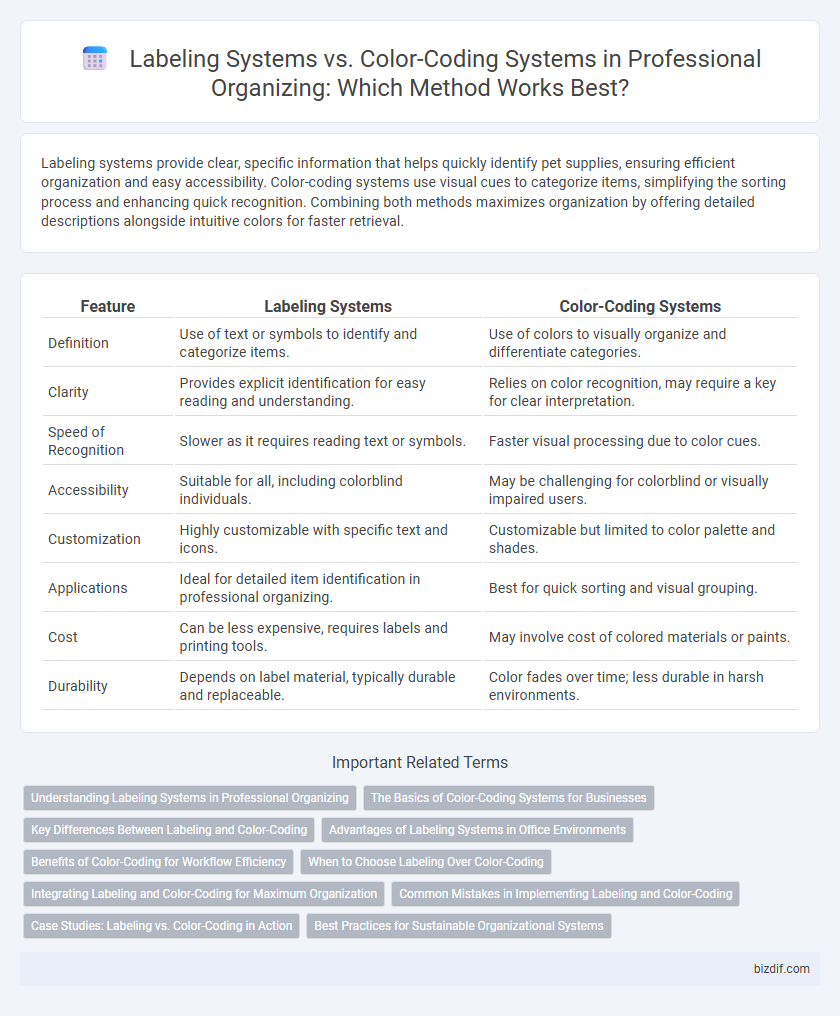Labeling systems provide clear, specific information that helps quickly identify pet supplies, ensuring efficient organization and easy accessibility. Color-coding systems use visual cues to categorize items, simplifying the sorting process and enhancing quick recognition. Combining both methods maximizes organization by offering detailed descriptions alongside intuitive colors for faster retrieval.
Table of Comparison
| Feature | Labeling Systems | Color-Coding Systems |
|---|---|---|
| Definition | Use of text or symbols to identify and categorize items. | Use of colors to visually organize and differentiate categories. |
| Clarity | Provides explicit identification for easy reading and understanding. | Relies on color recognition, may require a key for clear interpretation. |
| Speed of Recognition | Slower as it requires reading text or symbols. | Faster visual processing due to color cues. |
| Accessibility | Suitable for all, including colorblind individuals. | May be challenging for colorblind or visually impaired users. |
| Customization | Highly customizable with specific text and icons. | Customizable but limited to color palette and shades. |
| Applications | Ideal for detailed item identification in professional organizing. | Best for quick sorting and visual grouping. |
| Cost | Can be less expensive, requires labels and printing tools. | May involve cost of colored materials or paints. |
| Durability | Depends on label material, typically durable and replaceable. | Color fades over time; less durable in harsh environments. |
Understanding Labeling Systems in Professional Organizing
Labeling systems in professional organizing enhance clarity and efficiency by providing specific, readable text that identifies the contents or purpose of storage containers and spaces. Unlike color-coding systems, which rely on visual cues and may require prior knowledge of the color meanings, labeling offers explicit information, making it accessible to all users regardless of color perception. Effective labeling uses clear fonts, concise wording, and durable materials to ensure longevity and ease of use in any organizational environment.
The Basics of Color-Coding Systems for Businesses
Color-coding systems enhance business organization by assigning specific colors to categories, improving visual recognition and reducing search time. Implementing consistent color codes for inventory, files, or customer segments streamlines workflow and increases efficiency. These systems support quick decision-making and minimize errors by providing an intuitive method to classify and access information.
Key Differences Between Labeling and Color-Coding
Labeling systems provide clear, specific text-based identifiers that enhance easy recognition and precise categorization of items, making them ideal for complex or detailed organization tasks. Color-coding systems rely on visual cues through distinct hues, facilitating quick identification and intuitive sorting but may lack detailed information without accompanying labels. The key difference lies in labeling's emphasis on explicit, readable information versus color-coding's focus on rapid visual differentiation, impacting their effectiveness depending on organizational needs and user preferences.
Advantages of Labeling Systems in Office Environments
Labeling systems in office environments provide clear, specific identification of files, supplies, and equipment, enhancing productivity by reducing search time. These systems support consistency across departments and are easily scalable as office needs evolve. Unlike color-coding, labels offer detailed information that minimizes errors and improves overall organization accuracy.
Benefits of Color-Coding for Workflow Efficiency
Color-coding systems enhance workflow efficiency by enabling quick visual identification and categorization of tasks, documents, or supplies, reducing the time spent searching for items. This method improves task prioritization and minimizes errors by creating intuitive organizational patterns that the brain processes faster than text-based labels. Implementing color-coding in professional organizing increases productivity, streamlines communication, and supports sustained focus in busy work environments.
When to Choose Labeling Over Color-Coding
Labeling systems are ideal when clarity and precision are essential, such as in environments requiring detailed identification like offices or medical storage. They facilitate quick access to specific items by providing exact names or categories, reducing confusion and improving efficiency. Choose labeling over color-coding when the audience includes individuals who may have difficulty distinguishing colors or when consistent, unambiguous information is critical.
Integrating Labeling and Color-Coding for Maximum Organization
Integrating labeling and color-coding systems enhances professional organizing by combining clear textual information with visually distinct color cues, streamlining item identification and retrieval. This dual approach maximizes efficiency in storage spaces, reducing search time and minimizing clutter. Employing durable labels paired with a consistent color palette supports sustained organization and adaptability across various environments.
Common Mistakes in Implementing Labeling and Color-Coding
Common mistakes in implementing labeling and color-coding systems include inconsistent application of labels, leading to confusion and inefficiency. Overcomplicating color schemes without clear standards often results in misinterpretation and clutter. Neglecting user training on the system's logic reduces adherence and overall effectiveness in maintaining organized spaces.
Case Studies: Labeling vs. Color-Coding in Action
Case studies reveal that labeling systems excel in environments where precise identification and detailed information are critical, such as in legal offices and medical facilities, ensuring high accuracy and efficiency. Color-coding systems demonstrate their strength in settings like warehouses and retail stockrooms by enabling rapid visual categorization that reduces retrieval time and error rates. Combining both methods in hybrid approaches often leads to optimized workflow, balancing clarity of information with speed of recognition.
Best Practices for Sustainable Organizational Systems
Labeling systems enhance clarity by providing explicit descriptions that reduce ambiguity, making them essential for sustainable organizational systems in professional organizing. Color-coding systems improve visual recognition and speed up item identification but require consistent application and consideration of colorblind accessibility to maintain effectiveness over time. Combining clear labels with intuitive color codes creates a durable, user-friendly organization strategy that supports long-term maintenance and adaptability.
labeling systems vs color-coding systems Infographic

 bizdif.com
bizdif.com